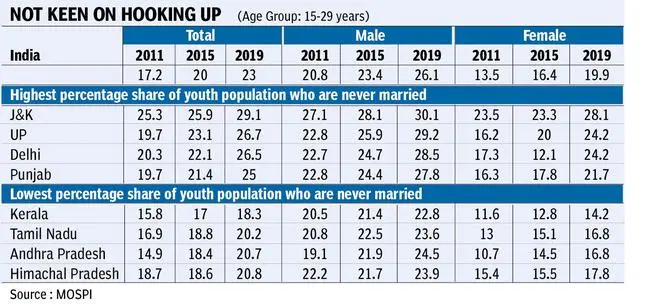
The percentage of youth (15-29 years) who are never married has shown an increasing trend in male population from 20.8 per cent in 2011 to 26.1 per cent in 2019 | Photo Credit: NISSAR AHMAD
The percentage share of young people who are not married is on the rise, a report by the Statistics Ministry shows. Significantly, the trend is common among men as well as women.
The National Youth Policy 2014, classifies persons between the age group of 15 and 29 years as “youth”.
“The percentage of youth (15-29 years) who are never married has shown an increasing trend in male population from 20.8 per cent in 2011 to 26.1 per cent in 2019. A similar trend has been observed in the case of the female population,” the report titled “Youth in India, 2002” showed.
The report has been prepared by the Social Statistic Division of the National Statistical Office (NSO) under the Statistics Ministry using published official data from different ministries and departments.
According to the report, in 2019, the highest percentage share of youth who never married was observed in the States/Union Territories of Jammu & Kashmir followed by Uttar Pradesh, Delhi and Punjab and the lowest was observed in Kerala, Tamil Nadu, Andhra Pradesh and Himachal Pradesh.

Although the report does not detail any reasons for this trend, government officials attributed it to “lifestyle and influence of celebrities”.
“Not getting married or becoming a single father/mother is considered woke. It signifies a modern lifestyle. The mindset is prevalent in mid and smaller cities also… Also, some celebrities when they say they are not going to marry influence young minds,” an official said.
Interestingly, this development has taken place when sex ratio of the total population (females per 1,000 males) went up to 1020 in 5th round of National Family Health Survey from 991 in previous round. Many states recorded improvement in the ratio so this cannot be a factor in people not finding life partners, say officials
The report said that India’s population, which reached 1211 million in 2011 and projected to reach 1363 million in 2021 ,was one of the youngest in the world, with 27.3 per cent of its population aged 15–29 years. In terms of absolute numbers, between 2011 and 2036, because of the declining fertility and increasing life-expectancy, the population pyramid of the country will undergo a shift.
While the proportion of population aged under 15 years is projected to decline, the elderly in the population is expected to increase. “The youth population is expected to increase initially but will start to decline in the latter half of 2011-2036 period. The total youth population increased from 222.7 million in 1991 to 333.4 million in 2011 and is projected to reach 371.4 million by 2021 and thereafter decrease to 345.5 million by 2036,” the report said.
The upside is that India still continues to be a very young country. It is home to a fifth of the world’s youth demographic and this population advantage could play a critical role in achieving the nation’s ambitious target to become a $5 trillion economy.
Published on July 13, 2022

Comments
Comments have to be in English, and in full sentences. They cannot be abusive or personal. Please abide by our community guidelines for posting your comments.
We have migrated to a new commenting platform. If you are already a registered user of TheHindu Businessline and logged in, you may continue to engage with our articles. If you do not have an account please register and login to post comments. Users can access their older comments by logging into their accounts on Vuukle.